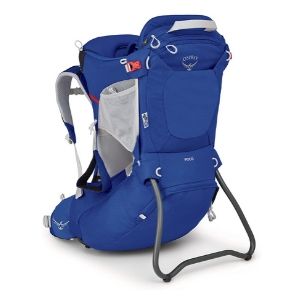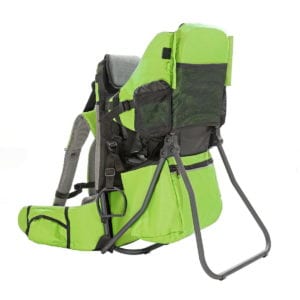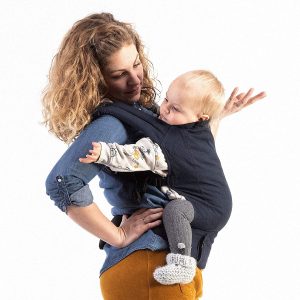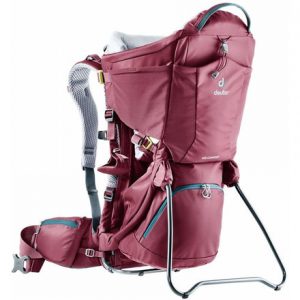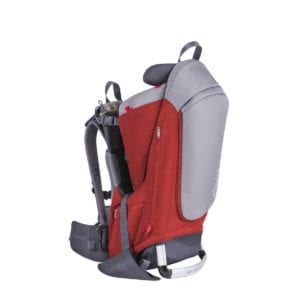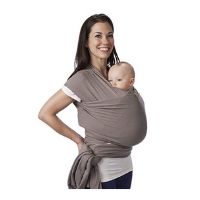The Best Baby Carriers for Hiking in 2021
Looking for a baby carrier designed to help you hit the trail with your little one?
We’ve sorted the most popular baby carriers according to our research, expert ratings, and customer reviews to determine which baby backpacks deliver the strongest all-around functionality and safety.
The best baby carriers for hiking in 2021
- : Top pick
- : Lightweight and affordable
- : Best for newborns
- : Luxury pick
- : Most extras
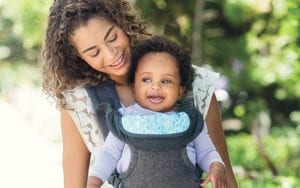
Compare the top hiking backpack carriers
*Amazon.com price as of 6/7/2021 at 7:25 a.m. (MT) (Full disclaimer)
Best hiking baby carrier reviews
1. Osprey Poco Child Carrier: Top pick
A consistent favorite of parents and testers, the Osprey Poco is a top-of-the-line baby carrier that includes AirSpeed suspension for carryability and ventilation and has one of the most stable frames of any hiking child carrier backpack. Maximum recommended weight is 48.5 pounds.
An extra-wide base, locking foot bar, and dual grab handles provide stability as you load and unload your child.
Storage isn’t a concern with the Poco. A removable pack provides all the extra storage you need to keep your little one's supplies handy. Plus, you can use it on its own for shorter urban hikes or walks.
Note that it's not for infants, though. The minimum weight is 16 pounds—you can’t use the Poco until your little one can hold their head up. There is no insert or adjustability to accommodate smaller babies.
And the price tag reflects its quality. It’s hard to get top-of-the-line benefits without a top-of-the-line price tag, and the Poco is no exception. This baby backpack will cost a little bit more than most, but reviewers say the perks are worth it.
2. Clevr Baby Backpack Cross-Country Carrier: Lightweight and affordable
The Clevr Baby Backpack is the least expensive framed carrier on our list, which makes it a favorite of budget-conscious parents. At five pounds, parents report loving the lightweight construction of the Baby Backpack Cross-Country Carrier.
This fixed-frame baby carrier backpack features impressive storage. You’ll find a place for everything, with multiple pockets, two water bottle holders, and an extra-large pocket that’s a perfect fit for diapers.
However, across the board, users find this backpack to be less comfortable than others, with limited padding and no foot pegs for the child.
And the size and strength of the waist belt and padding aren’t sufficient to avoid slipping and bunching during wear. This carrier is recommended for children between 16 and 40 pounds.
3. Boba Classic 4GS Carrier: Best for infants
The Boba Classic 4GS is a soft pack that grows with your baby; however, it may be uncomfortable on longer treks due to its frameless and less breathable design.
It's a front-facing carrier for infants weighing at least 7 pounds. It can also be used as a back carrier for toddlers up to 45 pounds. We love that it includes a booster insert to make it more comfy for newborns and supports different sitting positions.
The sleep hood is great for napping newborns or general sun protection. Additionally, the Boba is designed for ease and comfort during nursing, so you don’t have to worry about making complicated rearrangements to feed your hungry baby on the trail.
Parents will also appreciate the smartphone pocket on the waist belt.
But it does have its faults. Because the Boba is a soft pack, you don’t have the same convenience and stability you would loading your baby in and out of a freestanding, hard-frame carrier.
Also, keeping your baby carrier clean is important, so the Boba’s penchant for attracting lint has been one of the top complaints of parents.
If you've previously used or considered a Boba 4G, you might know that adjustability and parent comfort were common complaints. Fortunately, Boba seems to have listened to their customers. The 4GS iteration includes strap extenders to make this pack more comfortable to parents of all shapes and sizes.
We're disappointed that Boba decided to discontinue the 4G's foot stirrups when designing the Classic 4GS. As your baby grows into a toddler, they won't have this extra support for their feet.
4. Deuter Kid Comfort Child Carrier and Backpack: Luxury pick
The Deuter Kid Comfort is one of the most expensive backpacks on our list, but the solid construction and loaded extras keep it a favorite for parents and reviewers. Recommended for children who can hold their head up and who weigh less than 48 pounds. If you add gear to the pack, the total weight of the child plus gear shouldn't exceed 48 pounds.
This carrier boasts a five-point harness, chin and head cushion, and foot stirrups for your little one, which keeps their weight evenly distributed for ultimate comfort.
A viewing mirror gives you eyes in the back of your head, making it easy to monitor your baby throughout the hike. It also comes with a sun shade.
As for downsides, the backpack itself is pretty heavy at seven pounds.
5. Phil&Teds Escape Baby Carrier: Most extras
Loaded with extras, the Phil&Teds Escape offers comfort, safety, and perks. Suitable for children ages three months to three years.
The Escape comes standard with a sleeping hood, changing pad, removable daypack, rain shield, mirror, and foot stirrups. And baby is all set for a trailside nap thanks to the moldable headrest and shoulder cradle that offer snug support to developing neck muscles.
You can safely load and unload baby in this secure backpack that features two carry handles and a pop-in and pop-out stand that makes it easy to safely set the pack down—even with one hand.
But note that all that stability, plus extras, equals a pack that’s fairly heavy even before you strap your little one in.
This backpack comes with a generous hydration pouch, but despite so many other included extras, the water bladder has to be purchased on its own.
Your ultimate choice of a hiking carrier depends on your personal preferences when it comes to storage and long-term comfort. But if we were the ones hitting the trail with a toddler, we'd choose the Osprey Poco. We love that it combines stability, storage, and comfort. It's a splurge, but totally worth it if it means less whining.
As with all things "kid," things go in and out of fashion. Some of our original picks for best baby hiking carriers were no longer available. We scoured the internet to find brands with good reputations and reviews. We compared their features and prices to compile a buying guide.
In the next section, you can read more about the details we prioritized.
Things to consider in a hiking baby carrier
Choosing the right baby carrier for hiking with your baby can feel overwhelming. It’s difficult to know exactly what you’re going to need. Safety, while certainly the most important factor, is one of many considerations that will impact how comfortable you both are and how long you’ll be able to stay on the trail.
Harness and cockpit security
The most important consideration when choosing a baby carrier for hiking is whether or not it will keep your baby safe. A secure child harness and supportive cockpit are must-haves.
- Harness security
A secure harness keeps your child safe during every trek. Look for harness systems that are adjustable and comfortable around their legs, shoulders, and arms. - Cockpit safety
The cockpit is the area where your baby sits in the carrier. You want a well-designed cockpit that provides ample support for the neck, head, and back, as well as cushioned support in the front in case baby nods off during the hike.
Age and weight recommendations
It’s exciting to take baby on their first hike, but make sure that the baby carrier you choose is appropriate for your child’s weight and age.
- Age Considerations
Most baby backpacks will provide a recommended age range for use. If you’re eager to take out a newborn, be sure the carrier you use provides the right neck and head support. A baby typically won’t be able to ride in a backpack until they can hold up their head and neck on their own. - Weight Considerations
Along with age, baby carriers come with a recommended weight capacity. This is important for you and your little one, as you want to make sure the hiking carrier you use can support your baby’s weight. Consider how long the backpack will last as your child grows. For reference, the average three-year-old weighs up to 38 pounds.2
Hiking carrier versatility
Baby backpacks aren’t a small investment—make a purchase that will accommodate your hiking needs as long as possible.
- Adjustable sizing
Because you probably won’t be the only one carrying your baby in the great outdoors, you want a baby carrier that easily adjusts to fit different adult body shapes and sizes. You don’t want to have to buy two packs for one child just so you and your partner can trade off carrying duty. - Multiple functions
Many hiking baby carriers are designed to safely carry your baby from infancy to toddlerhood. As your baby grows, they'll prefer to sit in different positions. For example, newborns often need a carrier that supports their tendency to curl up into the "froggy" position, but toddlers might feel more secure with foot stirrups. A great hiking baby carrier will be comfy for more than one growth stage.
Extra features for comfy hiking
When you strap on a baby backpack, you want it to carry as many extras as possible. You certainly don’t want to add a diaper bag to the supplies you need to transport.
- Storage
The thing about taking a baby on a hike is that they come with extra baggage like diapers, bottles, and snacks. Consider the number and size of storage pockets and look for places to carry other essentials like water and your phone. - Free-standing design
The last thing you want to do is knock over your baby while trying to set them down or buckle them in. A solid, easy-to-deploy kickstand is a must
- Accessories
Both you and baby will be more comfortable with a few perks. Accessories like sun shades, rain covers, key/toy rings, and drool pads can make your adventures into the outdoors more pleasant.
More about baby safety
Want to learn more ways to keep your baby safe while on the move? Check out our Baby and Child Safety FAQ page, where we provide the answers you need to protect your little one.
FAQ
Technically you don't need one, but they do make things easier on long, hot days thanks to more even weight dispersal and ventilated design. Otherwise, you'll have to use your arms to hold your kiddo when they get too tired to walk.
If the terrain isn't too bad, you could use a cross-country stroller instead. Infants can also be bundled up in a wrap.
It depends on each specific carrier. Some are suitable for infants thanks to extra head and neck support. Others require children to hold their head up independently, which usually happens around the age of six months.
It depends on the specific carrier. The maximum load for a baby hiking carrier also factors in the weight of any accessories in the pockets. Children usually outgrow carriers around the age of three or four.
Each baby hiking backpack should come with its own fitting instructions. In general, they include a hip belt, shoulder straps, and a chest strap, all of which should cross the body at specific points and fit snugly but not uncomfortably tight.
With a freestanding carrier, the kiddo gets strapped in while the carrier sits on the ground. You then lift the carrier and put it over your shoulders like a backpack. You can then snug up the hip and chest straps to make sure your child doesn't slide around.
Related articles on SafeWise
Sources
1. Outside Business Journal, “Osprey Packs Introduces Award Winning Anti-Gravity Technology into Hydration and Kids Carriers for Spring 2016,” July 2015. Accessed June 7, 2021.
2. Cincinnati Children's, "Growth, Range of Height and Weight," April 2019. Accessed June 7, 2021.
Disclaimer
*Amazon.com list price as of 6/7/2021 7:25 a.m. (MT). Product prices and availability are accurate as of the date/time indicated and are subject to change. Any price and availability information displayed on Amazon at the time of purchase will apply to the purchase of this product. Safewise.com utilizes paid Amazon links.
Certain content that appears on this site comes from Amazon. This content is provided “as is” and is subject to change or removal at any time.
The post The Best Baby Carriers for Hiking in 2021 appeared first on SafeWise.
Article source here: The Best Baby Carriers for Hiking in 2021
